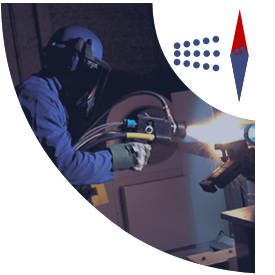 Most frequently, metal coatings are applied by thermal spraying. In this process, the coating material is heated to achieve a plastic or liquid condition inside a spray gun and then sprayed and deposited onto a pre-prepared surface which does not begin to melt during this process.
Most frequently, metal coatings are applied by thermal spraying. In this process, the coating material is heated to achieve a plastic or liquid condition inside a spray gun and then sprayed and deposited onto a pre-prepared surface which does not begin to melt during this process.
In most cases, bonding of the coating to the substrate is purely mechanical in nature. This fact enables materials to be sprayed onto any substrate and materials incompatible in terms of metallurgy to be joined (spraying of a metal onto concrete or coating a lower- with a higher-melting material, etc.).
Substrate temperature may be low while a hot coating material is being sprayed onto it. This fact prevents the substrate surface from undergoing deformation on being coated.
The mechanical nature of bonding causes that the preparation of workpiece surface which precedes the thermal spraying of layers, is a factor of paramount importance among the factors affecting the quality of the resulting bond.
Of the thermal spraying techniques, those most frequently applied include flame spraying. arc spraying, plasma spraying, and supersonic spraying (HVOF).
